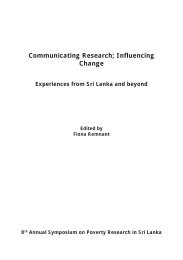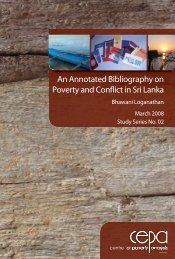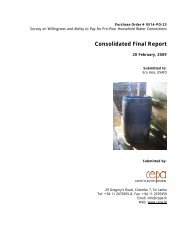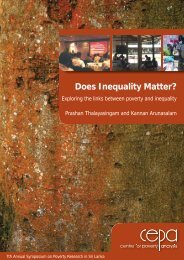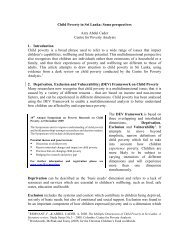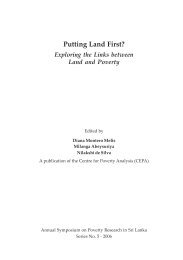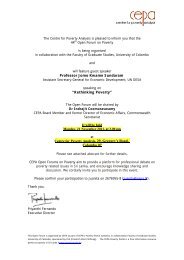Involuntary Displacement and Resettlement â Policy and ... - CEPA
Involuntary Displacement and Resettlement â Policy and ... - CEPA
Involuntary Displacement and Resettlement â Policy and ... - CEPA
- No tags were found...
You also want an ePaper? Increase the reach of your titles
YUMPU automatically turns print PDFs into web optimized ePapers that Google loves.
Foreword<strong>CEPA</strong>’s annual symposium on poverty has now become a regular notableevent in the intellectual calendar of Sri Lanka. Over the years, participationin the symposium, which focuses on a particular aspect of poverty everyyear, has exp<strong>and</strong>ed. Although the main language of the symposium isEnglish, simultaneous translation of the proceedings into Sinhala <strong>and</strong> Tamilhas contributed to opening up the event <strong>and</strong> the body of knowledge to awider audience. This year’s symposium attracted over 80 people includingresearchers, academics, policy makers, university students, media personnel<strong>and</strong> representatives of development agencies, interested <strong>and</strong> involved indisplacement <strong>and</strong> resettlement issues.The 9th symposium focused on involuntary displacement <strong>and</strong> resettlement.Large scale resettlement of people is nothing new to Sri Lanka. Irrigation ofthe dry zone <strong>and</strong> settlement of people in these areas became a significantdevelopment strategy of this country, some of it starting in the colonialperiod. The more significant projects were implemented in post-colonial SriLanka. The Accelerated Mahaweli Project remains one of the largestdevelopment projects ever undertaken by Sri Lanka.As the papers in the volume show, in recent times, involuntary displacementhas become complicated. A number of factors have contributed to it. Thecivil war that has ravaged the country for more than two decades, the 2004tsunami <strong>and</strong> large scale infrastructure projects have resulted in displacement<strong>and</strong> resettlement. In other words, Sri Lankan displacement has been due toconflict, natural disasters <strong>and</strong> development. This raises a complex set ofissues both in underst<strong>and</strong>ing the processes behind displacement, <strong>and</strong> in thesearch for policies <strong>and</strong> practices that deal with involuntary resettlement. It istherefore important to take into account different contexts in whichdisplacement occurs while also being conscious that varying resettlementpolicies <strong>and</strong> programmes can potentially aggravate inequities amongdifferent affected groups as well as among their host communities. Thisvolume is a contribution to this debate on improving policies <strong>and</strong> practicesfor all forms of displacement <strong>and</strong> resettlement.Sunil BastianFormer Chairman, <strong>CEPA</strong>vii



